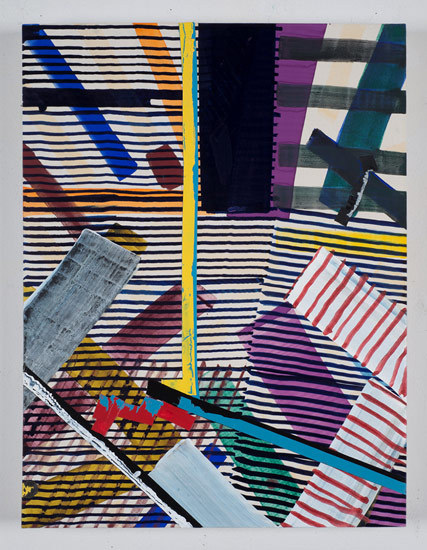
Juan Uslé’s exhibition is now in its final days and ends next Saturday, July 6th. Come by the gallery to see the exhibition and get a free Uslé poster if you mention this post.
The poster features this painting (shown above), titled “Siete Suelos” which translates to “Seven Floors.” To read about the inspiration behind this painting, Uslé beautiful text below provides some better understanding into this stunning work.
SEVEN FLOORS by Juan Uslé
I met Borges in the summer of 1983. I was painting at that time in the middle of a forest, in an old mill that generated light and paintings through water power. The river passed very close by the house, part of its course running right below where Vicky and I would play at coloring our dreams.
He was seated, I remember well, at that oval-shaped chestnut table, with two other people whom he addressed in a measured, low voice. He spoke to them of the Alhambra and its interminable “true stories”: “It is now a place of dreams,” he said, “where Moors and Christians are nothing more than middle-class brothers. Now they both share in the enjoyment of its precious gardens and even take turns tending them.” He explained that in one of the towers, called the Tower of the Seven Floors, a painter named Raphael Alajum used to work. He was skilled and very talented, but not very industrious. “The strangest thing about his work,” he said, “is that depending on the space, or the level that he occupied while painting, his works would take on a wholly distinctive character, a unique spirit. Thus his paintings could turn out to be light and poetic or, on the contrary, extremely complex and baroque—so much so that in his studio I was able to see, simultaneously, seven different forms or styles of making art.”
I was standing nearby listening to him, and when I came over to sit down, he turned his head toward me, seeming to recognize the sound of the keys that I had inadvertently laid on the table. According to Borges, the seven keys on Raphael’s key chain corresponded to each of the seven floors of his studio tower, and although he didn’t need them to go from one floor to another, he always carried them with him, thus reminding us that only he was able to do so.
I remember that Borges was wearing dark glasses, and owing to the rhythmic movement of his head as he spoke, it seemed as if he were reading, or perhaps following a dictation of voices that we could not discern. For a moment he took them off, laying them on the table, and turned his head slowly toward each of us. But he did not look at us; in reality his eyes, half-closed, seemed to be covered by a sort of membrane of multiple colors. Later I learned from Maria, his wife, that each morning, before shutting himself away at his writing, he had his eyes tinted with simultaneous bands of color, carefully selected, almost always arranged vertically and sometimes also juxtaposed; but never, not on a single day since she lived with him, did he use the same colors or sequences twice.
That meeting lasted some three hours, during which time only he spoke, always in the same tone, deep and measured, linking different stories until he reached a total of seven. His unerring words seemed to describe the same stories painted by Raphael. For a moment I had the impression that Borges was starting to retell a story he’d already told, but that wasn’t so; now the story was being told in exactly the opposite order from the previous one, beginning at the end, and moreover, each word seemed to be inverted, as if reflected in a mirror, thus taking on new forms and sounds, giving rise to new words and sentences, to a new story. Right during the seventh one, before he finished, it seemed to me that Borges was lamenting that the American writer Washington Irving had taken two stories from his imagination, as well as two colors; and he ascribed this in part to the key chain that Raphael always carried. That was the only way, he explained, to understand this occurrence, as well as the disappearance of two indispensable volumes from his infinite Library of Babel.
